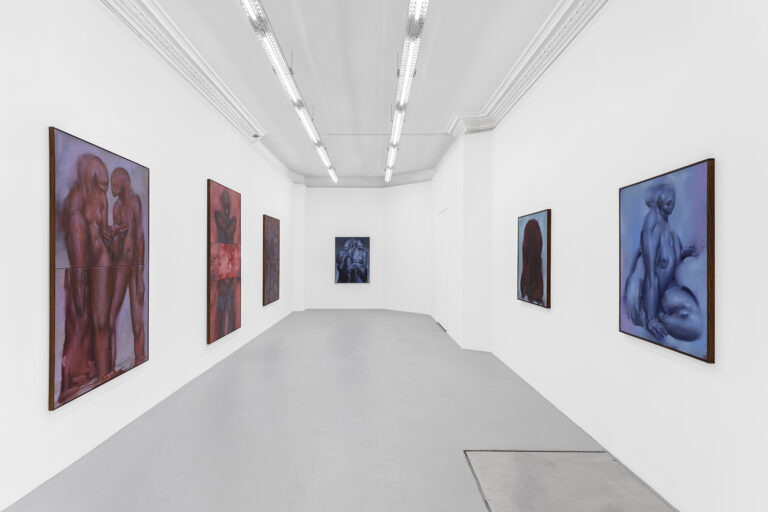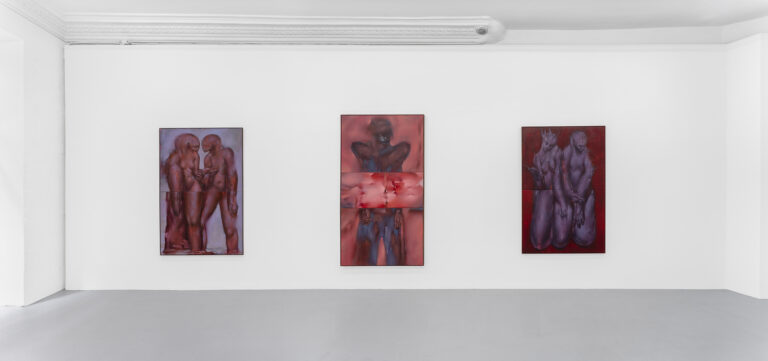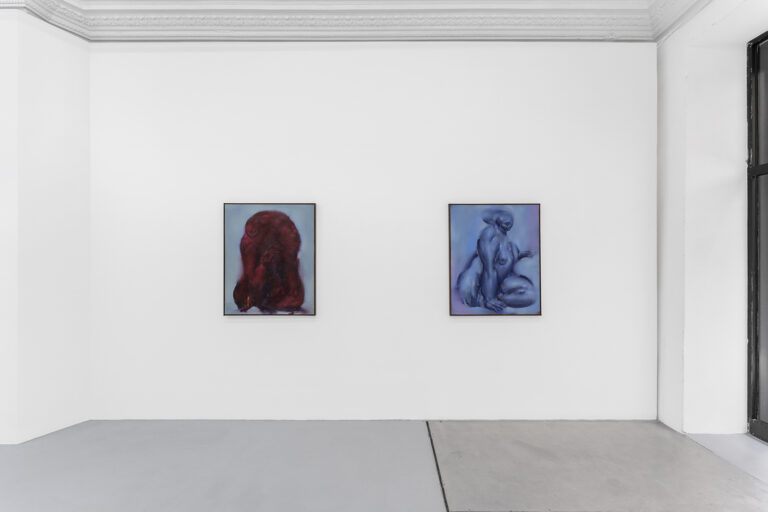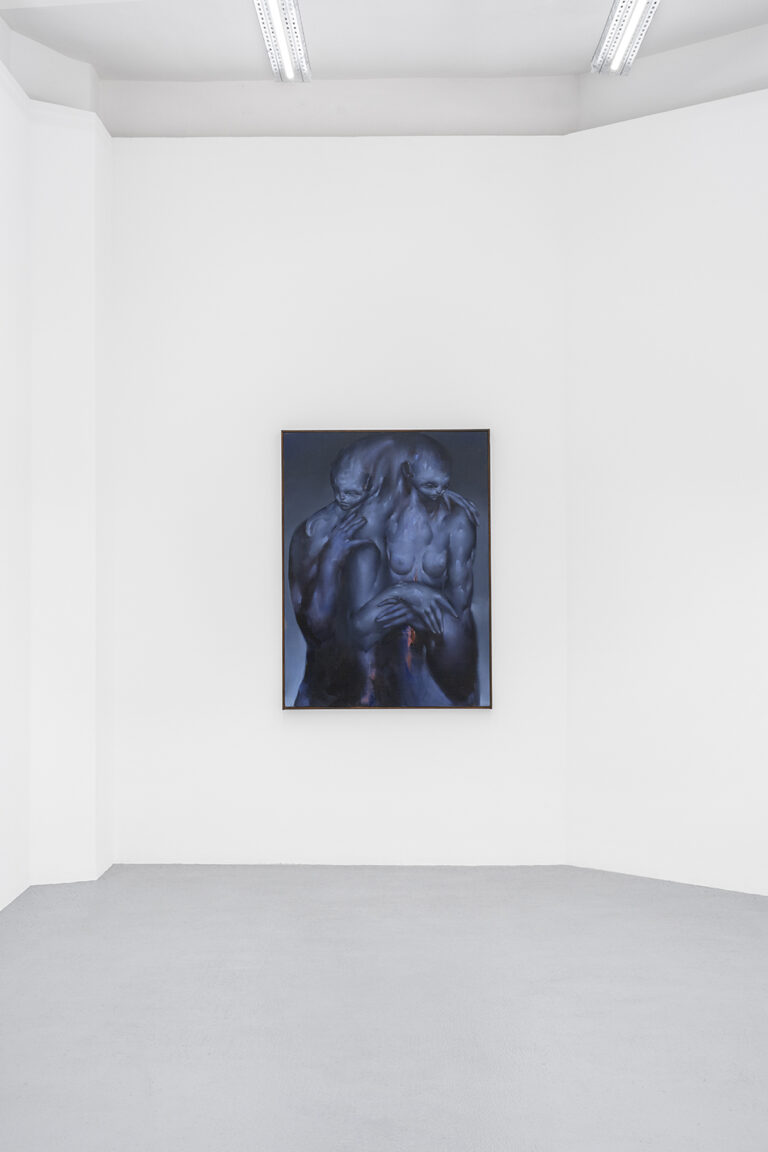Théo Viardin
Enigma
June 27 - July 27, 2024
«Great things remain for the great, the abysses for the profound, the delicacies and shudders for the refined, and, to sum up all this in brief, everything rare for the rare.»
Friedrich Nietzsche, Beyond good and evil, 1886
At the origin, the hybrid and sinuous question of otherness ostensibly stands out as a limbo with an uncertain and controversial perimeter.
The force imposed by the inescapable relational act often emphasizes fundamental questions that, in turn, constitute the foundations of the entire world—or, at the very least, of the human and animal world—and seal some of the most complex evolutionary structures that oscillate from the formation of individual consciousness to the most varied collective consciousnesses.
In this regard, the unmistakable pictorial approach generated by the hand of Théo Viardin appears fearlessly before our eyes, presenting itself as extremely visceral yet evanescent, flaming and enchanted, prude and profane, wavering between the corpulent and the vulnerable.
The colors smell of warm metal, the kind perceptible in blood flowing undyingly, and the forms appear diaphanous, intertwined, convoluted, and fluid, where in Man, creature and creator unite more than ever.
One glimpses a clear need, implicit and voluptuous—not exclusively erotic lust but almost brutally sensorial and carnally uplifting—aimed at undressing something that tends to remain veiled, through a game of back-and-forth between the inside and the outside, a dichotomous contortion of yearning contrasts that whisper the unspeakable to the ear of the innermost and profoundest humanity. All this without ever taking our eyes off the myth, and the imaginative processes rooted in the history of human beings and their most valid attempts to answer the mystery of life.
And it’s on the basis of such precepts that the enigma arises and seeps in—that mystery that challenges creators and spectators to seek deeper meanings and to appreciate the complexity and beauty of the unknown in order to create images and narratives that confront the immediate understanding of things and invite one to reflection—a clear reference to that posed by the Sphinx in relation to Oedipus in the course of the Greek myth popularized by Sophocles’ tragedy entitled «Oedipus Rex”.
In fact, according to the myth, when asked by the Sphinx, «What being, blessed with one voice, first has four legs in the morning, then two legs at noon, and three legs at night?» Oedipus sharply responds that it is «Man»—in the sense of a human being—for as a child he crawls on four legs, later walks on two feet in adulthood, and then uses a cane in old age. Despite the clue, the enigma cited here, teeming in every molecule of these incandescent and tragic pictorial traits, is twofold in that it concerns indeed the complexity of the human soul in relation to Oedipus’ response but above all refers to the figure of the Sphinx as another being, but equal or close to plausible.
So, we could say that it is a shaded and mysterious identity that represents alterity in its highest expression, already conscious of the resolution of the enigma, ready to disintegrate for the love of truth. It is none other than another human being, as are all of Théo Viardin’s entities that seem to tend beyond the tangible but actually simultaneously embody the poetic and raw aspects of the human being itself. In «Enigma,» the flesh and the body are always in the forefront, facing up to the naked other as a mirror image, a gateway to understanding the totality of things and ourselves, soliciting a dialectical observation that investigates authentic sensations and their formal becoming, corroborated—to the beat of layers of oil, vehement gestural brushstrokes, and dense, ethereal glazes—by the most rubicund chromatic alternations that undoubtedly define brand new concepts of both shape and space.
Domenico de Chirico
“Les grandes choses sont réservées aux grands, les profondes aux profonds, les douceurs et les frissons aux âmes subtiles, bref, tout ce qui est rare aux êtres rares.”
Friedrich Nietzsche, Par Delà Le Bien et Le Mal, 1886
À l’origine, l’hybride et sinueuse question de l’altérité se présente en apparence comme un limbe au périmètre incertain et controversé.
La force imposée par un acte relationnel incontournable attire fréquemment l’attention sur des questions fondamentales qui, à leur tour, constituent la base du monde – ou, tout du moins, celui de l’homme et de l’animal – et scellent certaines des plus complexes structures évolutives oscillant de la formation de la conscience individuelle à la conscience collective la plus variée.
À cet égard, l’approche picturale inimitable naissant de la main de Théo Viardin se révèle vaillamment à nos yeux, se présentant à la fois extrêmement viscérale et évanescente, flambante et enchantée, puritaine et profane, vacillant entre corpulence et vulnérabilité.
Les couleurs sentent le métal chaud, celui que l’on perçoit dans le sang qui coule continuellement, et les formes apparaissent diaphanes, entrelacées, courbées et fluides, où créature et créateur sont plus que jamais confondus en l’Homme.
On entrevoit une nécessité claire, implicite et voluptueuse – une attraction libidinale non seulement exclusivement érotique, mais presque brutalement sensorielle et charnellement enivrante – visant à déshabiller quelque chose qui tend à rester voilé, à travers un jeu de va-et-vient entre l’intérieur et l’extérieur, une contorsion dichotomique de contrastes désirants, qui chuchotte l’indicible à l’oreille de l’humanité la plus intime et profonde. Le tout sans jamais pouvoir ôter le regard du mythe et des processus imaginatifs enracinés dans l’histoire des êtres humains et de leurs tentatives les plus valides pour répondre aux mystères de la vie.
C’est sur la base de ces préceptes que naît et s’insinue l’énigme – mystère défiant créateurs et spectateurs à chercher des significations plus profondes et à apprécier la complexité et la beauté de l’inconnu afin de créer des images et des récits qui confrontent la compréhension immédiate des choses et invitent à la réflexion – une référence claire à celle posée par le sphinx à Œdipe dans le mythe grec popularisé par la tragédie de Sophocle Oedipe Roi.
En effet, selon le mythe, à la question du Sphinx : «Quel est l’être qui, pourvu d’une seule voix, a d’abord quatre jambes le matin, puis deux jambes à midi et trois jambes le soir ?» Œdipe affirme «l’homme» – au sens de l’être humain – puisque, enfant, il marche à quatre pattes, puis sur deux pieds à l’âge adulte, et enfin sur un bâton dans sa vieillesse. Malgré l’indice, l’énigme ici évoquée, grouillant dans chaque molécule de ces traits picturaux incandescents et tragiques, est en fait double : elle concerne autant la complexité de l’âme humaine, relativement à la réponse d’Œdipe, mais surtout fait référence à la figure du sphinx comme un être autre mais égal, ou proche du vraisemblable.
Nous pourrions donc dire qu’il s’agit d’une identité trouble et mystérieuse qui représente l’altérité dans sa plus haute expression, déjà consciente du dénouement de l’énigme, prête à se désintégrer par amour de la vérité. Celle-ci n’est autre qu’un être humain autre, comme toutes les entités de Théo Viardin, qui semblent se situer au-delà du tangible mais qui en réalité incarne simultanément l’aspect poétique et cru de l’humain lui-même. Dans «Enigma», la chair et le corps occupent toujours le premier plan, faisant-face à la mise-à-nu de l’autre comme un miroir de soi, porte vers la compréhension de l’ensemble du monde et de nous-mêmes, sollicitant une observation dialectique qui étudie les sensations authentiques et leur devenir formel, corroboré – au rythme des couches d’huile, des coups de pinceau véhéments et des glacis denses et éthérés – par les alternances chromatiques les plus rubicondes qui définissent indéniablement une conception inédite tant de la forme que de l’espace.
Domenico de Chirico





